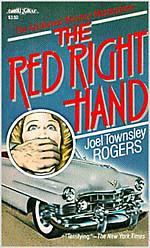[Home] [Parents] [] [JTR -- unannotated bibliography] [Siblings] [Maureen] [Joel] [Friends] [Places] [Publications] [Add your comments] [See Guestbook] [See old Guestbook] [Email me]

Joel Townsley Rogers
— Writings
Joel Townsley Rogers is best known for The Red Right Hand, which came out first in 1945 and has been reprinted several times since then. He published three other unsuccessful books as well. But his most popular, if not most enduring work, was his short stories, of which he published hundreds.
I'd like to be able to give a complete bibliography of his writings, but for the time being any bibliography will have to be tentative and incomplete. (I have provided a more straightforward listing, by date and without biographical and other digressions, on the webpage called "Joel Townsley Rogers — An Unannotated Bibliography".) He didn't keep copies of all his stories (in fact seemed rather proud of not having done so), and some of the ones he did keep copies of have disappeared or have fallen apart. I'll put together such information as I have and hope anybody with more information will contact me to fill in the gaps.
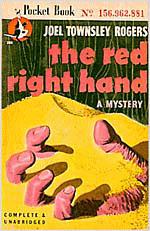
Evidently — from what he said in one of his letters — Joel wanted to be a writer when he was still a teenager. He jumped into this vocation while an undergraduate at Harvard, where he wrote for The Advocate and was part of the editorial board of The Crimson. His first book publication was a slender tome called Eight More Harvard Poets, which came out around 1920. (It followed by a couple of years Eight Harvard Poets, which, I believe, was E E Cummings's debut volume). One of the poets in that volume was Malcolm Cowley, who gained a lot more fame and wealth, over the ensuing years, than Joel ever was able to.
Joel left Harvard a year early, as a number of other students did, in order to offer himself to the military in the Great War. His Harvard diploma said "1917 as of 1918."
|
A fan letter to my father at twenty — just about the time he left Harvard to teach flying in Pensacola. I have no idea what the story was that was so praised. (The "little book" Peoscham sent was a forgettable collection of verses from the Advocate from the decade of the 1870s. It is resting now on Dave Humsey's bookshelf.)
June 7,1917
Dear Mr.Rogers:
I am sending you a little book,in token
of my great admiration for some of the qualities
shown in your story in the Advocate of May 28th.
Never let anybody persuade you to de-nature
yourself by form. The story shows certain
qualities of a higher grade than any other story
ever printed in the Advocate. The form takes
careof itself at Harvard.
Come to lunch with me sometime,if
you are in New York.
Yours truly,
WBPeoscham
Mr.Joel T.Rogers,
Harvard College,
Cambridge, Mass.
|
He joined the navy air corps and became one of its first few hundred flyers. He went through training in Hampton Roads, Virginia, and though he was aching to go overseas (and in fact managed to get himself in a position to do so, had the armistice not intervened) — the Great War seemed an adventure to the young men of that generation! — he was sent to Pensacola as a flight instructor instead. The planes he flew and taught others to fly were tiny pontooned biplanes made (he said in one of his letters) of spruce and linen.
After the war he made use of his experiences and vivid imagination to sell short stories to the raft of pulp magazines that sold in the 1920s and 1930s for fifteen or twenty cents.
From a 1962 letter to a Mr. Vreeland (whose connection with Joel I do not know):
How did I come to write stories? In college I'd done poetry and editorials and stories and articles for the college magazines. In the fall of '19, fresh from the service, jobs were scarce, and so I began writing. For absurd magazines called Snappy Stories, and the like. Better than working at a job, I thought. For three years I wrote a little book-review magazine in New York, and became a kind of pundit....But I didn't [stay with that job], because I'd got married, and the job didn't pay enough. So I began writing reams and reams of imaginary war flying stories, for swarms of magazines which were popular at the time. And when the magazines died away, it was too late for me to get an honest job. In fact, if one says one has been a fiction writer, it is like saying one has been a strip-tease artist. You may have a brain, but it is doubtful.
|
The dedication page of Once in a Red Moon, published when Joel Townsley Rogers was 26: OTIS JOEL ROGERS from whom I have consciousness of all tremendous Visions, the eternal Mysteries, the abiding Laws, the dreadful Awes, the cruel dog-driving Fates, and with that consciousness courage to meet them all, and death, this book is respectfully dedicated. |
I believe that it was in 1922 that Joel signed on as editor of Brentano's Book Chat. Brentano's at the time was not just a bookseller, but a publisher as well, and Book Chat was a company magazine of the same ilk asHarper's or Scribner's magazines. Lowell Brentano had been one of his classmates at Harvard, and when Joel submitted his first novel to him, Brentano, without much enthusiasm for the book, offered to publish it on the condition that Joel take the Book Chat editorship. Joel agreed, and Brentano's published that novel, Once in a Red Moon (which Joel later belittled) in 1923.
I had never suspected that there were any copies of Book Chat extant until coming to my brother's place in the fall of 1999 and finding a treasure trove of old magazines that I had thought were gone forever. Among these was a manila envelope containing six or eight copies of Book Chat — the earliest (volume 2, number 2) dated midwinter 1923 and the latest January-February 1925. The summer 1923 issue (volume 2, number 4) is the first that lists Joel Townsley Rogers as the editor. The magazine came out six times a year, and at first was free. In 1924 the price was raised to fifteen cents a copy (fifty cents a year), and along with Joel's name on the masthead, Roger Curley is listed as associate editor and L. Stuart Rose as art editor. Roger Curley was a pseudonym Joel used sometimes at Book Chat so he'd have someone to argue with in order to make the magazine a little more exciting. The pseudonym came from his navy air nickname, Curly Rogers — from his curly hair.
I'm not sure when Joel left Brentano's, but when he did Stuart Rose took over as editor of Book Chat. Rose later enjoyed a comfortable existence as an editor at The Saturday Evening Post — where, over the course of the years, it fell to him to reject many of Joel's stories, some of them several times in succession, and to accept a very few.
For an example of Joel's writing as editor of Book Chat — and an impression of how he was affected by his first meeting with Chase Osborn — see his article "Bound in Genuine Human Parchment — Chase S. Osborn," which appeared in the January-February 1925 issue.
Joel had sold numerous stories before he took on the Brentano's job. His first sale, as I had seen mentioned in a couple of letters, was to Snappy Stories and his second to Harper's. But I hadn't had any idea of how many other stories he'd sold, or the names of the publications or the themes of the stories, until coming to my brother's place in 1999 and looking through the box full of old magazines he brought out for me. Most of the early stories appeared in Snappy Stories and most were light, humorous fluff. At first he avoided using his own name and instead brought the Roger Curly pseudonym (slightly changed) over from Book Chat. (When he had more than one piece in an issue, he also used the pseudonym J. R. Townsley.)
- "The Battle Cruiser Lady." ("By Roger Curly.") Snappy Stories 49(1), 18 February 1920:57-61.
I assume that this story was Joel's first sale.
"My friend Cyrus is a most terrible cynic about women: not with the sadly smiling cynicism of old men, who have seen their idols go crashing down one by one, learning with humility and wisdom that frailty's name is man and woman and innocent children and everything else popularly endowed with a soul, but with the bitter cynicism of young men who have learned too much and learned it too thoroughly...."
- "The Pure in Heart." ("By Roger Curly.") Snappy Stories [49 (2)?], 4 March 1920:96.
"I never saw a man like Squibb. And Squibb never did until he looked in the mirror...."
- "The Romance of Mr. Butterthin." ("By Roger Curly.") Snappy Stories 50 (1), 4 April 1920:49-56.
"It is no joke to have a name like Butterthin, except to the world which does not have such a name. That world is very large, and very ribald, and very given to idiotic laughter at names which strike it as funny...."
- "A Cinema Siren." ("By Roger Curly.") Snappy Stories 50 (3), 18 May 1920:63-69.
"'The movies again to-night?' asked John's wife.
"'Why not?' asked John.
"'I wish you would stay at home with me some evening,' said John's wife.
"'Why should I?' retorted John. 'I seek romance. You are not romance. You are only my wife.'"
- "Tale of a Tail-Spinner." ("By Roger Curly.") Harper's, June 1920.
This seems to have been Joel's second sale, though not his second story published. Knowledge of this title and many others in this list have come to me from the researches of my nephew, Philip J. K. Rogers.
- "A Perfect Lady." ("By Roger Curly.") Snappy Stories 51 (1), 4 June 1920:85-88.
"Although they would have scoffed at him with none too covert sneers in Newport or Palm Beach, or in other places where the young bloods gather to make sport of the gods, yet in his own way and after his own lights he was a gentleman...." - "The Love Eternal." ("By Roger Curly.") Snappy Stories 51 (3), 4 July 1920:35-38.
"'And this is final, Norine? There is no chance that you might change in time — that you could ever learn to love me?'
"'I do love you, Will; but not that way. I'll try always —'
"'Don't tell me that you will be a sister to me, Norine!...'" - " Three on an Island." ("By Roger Curly.") Harper's, August 1920.
- "The Second Mrs. Jones." ("By Roger Curly.") Snappy Stories 52 (2), second August number,1920:23-24.
"True enough it was that Mrs. Jones wasn't anything especial to look at. But, then, who ever knew a Mrs. Jones who was anything especial to look at?..." - "The Curse of Adam." ("By Roger Curly.") Snappy Stories 53 (2), 25 September 1920:30.
"Adam, sitting alone in his garden beneath the shade of the pear tree, scratched his chin and his shin. He plucked a tobacco leaf and rolled it morosely...." - "Smokeless Powder." ("By Roger Curly.") Snappy Stories 54 (1), 25 October 1920:95-98.
"Not that she was less a thing to be adored and desired than other women, with her tropical gold beauty and her cruel tiger eyes, with her words which said, 'Stand away!' and her voice which said, 'Come!'..." - "The Clutching Hand." ("J. R. Townsley.") Snappy Stories 54 (1), 25 October 1920:99.
"We ate and laughed and drank together, although I knew that she was the wife of another man, and that there would be hell to pay if he discovered us...."
- "The Dangerous Sex." ("By Roger Curly.") Snappy Stories 54 (2), 10 November 1920:29-31.
"Margot Meadows, sweet eighteen and sweet to look on, traveling up to see her big new married sister at Weston-on-the-Hudson, raised her wide blue eyes from the Ladies' Home Companion and turned her golden head to look at the man across the aisle...." - "The Man with the Broken Hand." ("By J. R. Townsley.") Snappy Stories 54 (2), 10 November 1920:93-97.
"The door to Mr. Grevy's most sacred office opened, and the Man with the Broken Hand stood in the entrance...."
- "A Life Sentence." ("By Roger Curly.") Snappy Stories, [1921?]:35-39.
"This is a story you won't believe, because it is true. Nevertheless, if you go out to Spokane, Washington, any citizen, reputable or disreputable, will point out Barney Rooney to you as he walks down the street...." - "General Interrogation." ("By Roger Curly.") Snappy Stories, [1921?]:35-38.
"These questions I ask of the Sphinx, of the Delphic Oracle, or the Sybilline Leaves, of the Cheshire Cat and the Dodo Bird, yea, of Jove who thundered from Olympus, and Jahweh, who thundered from Sinai; of Brahma, Vishnu, and Shiwa; of the Parcae, the Eumenides, and the three Gray Norns; of the Fates who rule the Gods and the Fates who rule the Fates...." - "The Everlasting Flame." ("By Roger Curly.") Snappy Stories, [1921?]:87-90.
"Beautiful Beatrice Vail was dead, her quick heart stifled; her clear blue eyes closed before the dark agony of the night eternal; her beauties faded as irrevocably as the roses which blossomed round the Cyprian's bower or as the sunsets which fell on Babylon...." - "The Immorality of Elinor." ("By Roger Curly.") Snappy Stories, [1921?]:57-61.
"Both of them loved Big Jim Kennedy, for he was good to look on and he was rich. And Big Jim loved both of them, as he loved several others, which is, it seems to me, as good a reason as you may find. And since he loved both of them, Big Jim quite naturally wanted both of them, a thing not allowed by the law...." - "The Don and the Duello." ("By J. R. Townsley.") Snappy Stories, [1921?]:31-36.
"Don Orlando, the poppycock swordsman of Seville, strutted around the square, twirling his jaundiced mustachios...." - "Tales in the Tragic Tense." ("By Joel Townsley Rogers.") The Double Dealer, April 1921:160-162
Was this the first time Joel used his actual name? - "The Great Sherlock Solves Another." Ten Story Book, April 1921:40-42.
"'Watson,' said the great detective, 'you have been to the barber.'..." - "A Marriage of Convenience." ("By Roger Curly.") Ten Story Book, April 1921:53-56.
"A true love match it might have been called. There was no question raised that she was marrying him for his money, for she had as much as he; nor question of him marrying her for her money, for he had as much as she...." - "Mrs. Reynolds's Husband." ("By Roger Curly.") Snappy Stories 58 (2), 10 May 1921:51-60.
"Dunn found the door to Mrs. Reynolds's apartment, which had been open to him morning, noon, and as late into the night as he dared to use it, now firmly locked...." - "Lost Lady with the Amber Eyes." Young's Magazine, July 1921:218-224.
"You, of course, being a connoisseur of life, must wander down now and again to dine or sup in Greenwich Village. There is no life down there, of course, worth the living, but you can hobnob with the other connoisseurs, and pretend that you are drinking bohemia's scarlet lees...." - "Shadows of the Silver Screen." Screenland, August 1921:36-37.
This is a poem, not a story.
"I am the Operator; I unreel
For you the flickering world.
All, all is here, mes bonhommes and fat ladies
For your polite applause or for your sniffles,
Or for your dulcet amorous ecstacies
Strummed to orchestral music...."
- "Roses Are Red." The Follies, November 1921:3-24.
"The time is silver evening, seven-thirty, seven bells of the second dog watch, by some -- all seafaring men -- denoted as Hell's bells.
"A silence lies over the great city, broken only by the steady tramp, tramp of the feet of Policeman Ariel McGurky as he monotonously wends his way past the gilded facade of the Rotterdam Roof, and wends it back again...." - "Bon Voyage." Snappy Stories 64 (3), 18 February 1922:81-88.
"Money, of course, is the root of all evil, as it is likewise the blossom of all pleasure. Mr. Walton had applied himself as earnestly to the digging up of this root as a hog snuffling out truffles with his snout...." - "Bramble-Thistles Stick." Publication and date unknown. (Mentioned in Adventure, 30 December 1922.)
- "Lover's Gold from Turon." Publication and date unknown. (Mentioned in Adventure, 30 December 1922.)
- "Mrs. Hubert's Love Affair." The Follies — the Magazine of Fascinating Fiction, April 1922:49- 63.
"August Dunn received the first letter as he was enameling his face for the opening show. It was like many others which came to him, though they were fewer than they had been twenty years before...." - "The Cigarette Fiend." Snappy Stories, First May number, 1922:67-73.
It takes very little to paint the town red when that town is Boston.
"Little Vera Tite danced. Boston looked at her. So did Mrs. Hathaway Boggs, with visage fatal and grim. But Hathaway himself seemed to be sleeping...." - "A Right to Rose." Fascinating Fiction, July 1922:45-54.
"A huge wicker basket of red roses from Stubboy for Rose Kildare. Beating the 'Irish Blues' with his knuckles on the dressing-room door, Pie-face O'Roon handed the basket in to Rose Kildare...." - "The Favors of Vera Tite." Snappy Stories, Second August number, 1922:61-72.
"August Dunn, the ham-faced actor, sat at a table with young Johnny Applejohn, nephew of the Nail Keg Trust. Every once in a while Dunn looked over his shoulder, thinking he heard little Vera Tite come in the restaurant. It was only the elevated outdoors...." - "Mail for the Whirlwind." Adventure, 30 December 1922:109-126.
"Old Martin Martel wanted little Sin-Din-Ding. He cast on her his wrinkled old, red old eyes one twilight as she stood by the ocean and decided she was good enough for Martin Martel...." - "They Lived, They Loved, They --." Metropolitan, May 1923:30-32,64-68.
"Sea calleth to sea within the night, beneath the stars, beneath the cloud, deep calleth to deep within the night. And lips call to lips with a language older than Aryan or Chinese...." - "The Goblin Sheep." The Lariat Story Magazine 2 (1), January 1926:1-21.
- Reprinted as "Cotton Cows." Action Novels 4 (6), October-November 1932:64-83.
Cyril the Sheik learns the difference between fur cows and cotton cows — packed with action and crowded with laughs!
"It was the day before Petroleum Geronimo went loco and scalped poor Jennie Bell (said Dizzy, the aviator of the west Texas sheep ranch) that the city gunman we called the Flea came rolling up to the Yard Wide gate with murder in his look...." - "The Other Man's Wife." Metropolitan, [month?] 1926:57-60,100-105.
"The Great Adventurer beat up the sky against the sullen rain. With a swift sparkle its lightning claws lashed down at him, and though he opened his motor with a threatening roar, it seemed to stretch forth a giant paw and hold him motionless in the wind....:"
- "Too Game to Die." War Novels 2 (33), September 1930:44-81.
BALTIC — A greedy glory-grabber stole his prey away; the fangs of the Kaiser's air, land, and sea-wolves snapped about him; but Aeneas Guernsey of Iowa, and fighting Yakee sailorman, was — Too Game to Die. A Novel of the War-torn Sea.
"The fat old cruiser, in her war paint of mottled gray and white, came steaming up the Baltic off the Kurland coast, toward sunset of a June day in '16. Behind her, in battle line, plowed five other scout cruisers, equally as fat, and somewhat smaller...." - "The Fighting Breed." War Stories 30 (87), November 1930:8-48.
Complete Novel of Our Gallant Tars. NORTH SEA — 48 battered seamen — scum and sweepings of the Yankee Fleet; at least that's what His Nibs, Commander Domfrey of the Royal Navy, thought!
"There were forty-seven hot, red-faced and muttering men in naval blues who came marching onto the drill-ground and down by the sea wall of the Swan Ness Destroyer Base, Royal Navy, at a tramp-tramp-tramp, in break-step tread, on a torried July noon in '17...." - "Cotton Cows." Action Novels 4 (6), October-November 1932:64-83.
[This is a revision, evidently by the editors, of "The Goblin Sheep."]
"The day before our own Petroleum Geronimo went loco and scalped poor Jennie Bell, the Boss' daughter, that bold, bad man we called the Flea came rolling up to the Yard Wide gate with quick death in his eye...."
Those are some of his early stories, but there were evidently others as well. In a letter to Arthur Sullivant Hoffman, editor of McClure's Magazine, on 12 aug 1927, Joel mentioned that when Hoffman had been editor of Adventure magazine Joel had sold him "The Fool Killer" and "Dead Red Ants." Judging from their titles, those are mysteries, so I have listed them in section V below.
In the early 1960s, after receiving a fan letter from Marvin H. Leaf, a Los Angeles dentist who had read "Night of Horror", remembered fondly some of Joel's old flying stories from thirty years before, and wondered if any of those stories (four of which Dr. Leaf still had in the original magazines) had been collected in book form, Joel began to consider the possibility of publishing a collection of some ot those old stories. A 1963 letter to Jack Byrne, an editor (of Action Novels, Wings, and perhaps some other magazines) and close friend of his (Byrne's mother was Ethel Byrne, Margaret Sanger's sister), said
I've looked over what air stories I have. Perhaps actually a somewhat more complete file of them than of later mysteries, which are almost totally missing. That due to my father, who died 21 years ago, and in whose basement I found five or six years ago a batch of old Wings and so on.That letter is where I found many stories listed. But recently, as I said above, I've found original copies of many other stories in a cardboard box at my brother's house. For those ones I'm able to give more accurate bibliographical information. My nephew, the renowned editor Philip J. K. Rogers, has dug up information about many others.
I've made a list of the old battered yellowed copies I have, with all stories except my own torn out, to save space. Not necessarily in chronological order, because with some I don't know the year, since the contents pages were torn out, and the spine with date may have become torn off.
For the stories I've had access to, I include squibs and the first one or two sentences.
- "The Smoke Trail." Part one. Three Star Magazine 1 (4), 24 May 1928:443-460.
–Part two. Three Star Magazine 2 (1), 14 June 1928:96-113.
–Part three. Three Star Magazine 2 (2), 28 June 1928:235-241.
–Part four. Three Star Magazine 2 (3), 12 July 1928:364-369.
[The first of the Jack Christmas stories?]
A Four-Part Air-Police Novel. Pretty Eileen Kilgore has vanished as if into thin air; and on top of this terrifying disappearance the entire Hudson River countryside is panic-stricken over a series of brutal and apparently clueless murders.
"In the late afternoon of Wednesday, September eleventh, Captain Jack Christmas of the new New York Aerial Police saw a curious craft swooping down from the southern sky toward the police flying field north of Manhattan. It was a biplane painted oriole orange, with a long torpedo-shaped pontoon beneath its fuselage...." - "Desperate River." [Place and date of publication unknown; mentioned on title page of "The Flame Jumper."]
- "The Yellow Hawk." Air Stories, September 1928:33-49.
Destruction rides high as Captain Jack Christmas, flying policeman, follows the trail of the Yellow Hawk. And Fate cold-decks them as they play their showdown hand — !
"In the pallid dawn a warning that the killer was abroad came by long-distance telephone to Happy Martin, who had change of the Lakefield flying school — Lakefield, Massachusetts, a hundred miles northeast of New York City...." - "The Sky Hook." Part one. Flying Stories, November [1928?]:17-30.
–Part two. Flying Stories, December [1928?]:26-39.
–Part three. Flying Stories, January [1929?]:43-54.
–Part four. Flying Stories, February [1929?]:62-74.
[No year on these torn-out stories, but a remnant of one of the magazines refers to the transatlantic flight of the Bremen — the first east-to-west solo, a year or so after Lindbergh's west-to-easter — earlier in the year, so evidently they came out in 1928-1929.]
"Captain Jack Christmas of the New York State Aerial Police, sturdy and yellow-haired and blue of eye, came flying a little sky-colored JN biplane back to his home field that cloudy October afternoon...." - "Secret Operative K-13." Part one. Everybody's Magazine, December 1928;352:64-90.
–Part two. Everybody's Magazine, January 1929;353:58-77.
–Part three. Everybody's Magazine, February 1929;354:140-162.
You never read a more thrilling or unusal story than this, a tale of intensely dramatic action behind the German lines, when the issue of the Great War lay in the hands of the fabulous spy known only as — Secret Operative K-13.
"At four o'clock of the afternoon General-Leutnant Paul Friedrich Hermann von Schmee, Freiherr von Eglesdorf, Gran fon Schlossheim, commanding officer of the Seventh Corps of Von Falkenhayn's Second Field Army, was enjoying Frühes Abendbrot met Tee on a terrace of the chateau of Oldemonde, in Hainaut southeast of Monds, when a solitary British Sopwith came diving down out of the sky...."
- "The Flame Jumper." Action Novels, April [year?]:69-84.
[Magazine cover indicates that this issue contained "Coyote Sign" by Eugene Cunningham and "The Green Doom" by William Chamberlain.]
You say it couldn't happen...too much like a hophead's dream. Well, hop into the flying boots of Captain Christmas and take off for the death cloud.
"Just before four o'clock of that cloudy June afternoon, King O'Kane came running across the air mail field at Hempstead, New Jersey...."
- "Blood on the Moon." Part one. Air Stories, September 1929:50-63.
–Part two. Air Stories, October 1929:64-77.
–Part three. Air Stories, November 1929:70-83.
–Part four. Air Stories, December 1929:88-98.
Treachery lurked in the cockpit, the Brandenburg ace and Fokker circus lay in wait. They trapped Scotty Carmarty, drove him down to his death. But his ghost rose up, haunting milehigh battlefields for vengeance....Epic of sky-tourneys — of a Yank Camel jockey and his fighting mates in the Ninety-Ninth. Of Reisenweg, air duellist, and the Iron Man, spy. Action, romance, intrigue of French air lanes and along the gun-choked road to London.
"At noon, fifteen miles inside the Hun lines and peaking for home through a cloud-patched sky, Captain Scotty Carmarty, top ace of Thanet's Ninety-Ninth B. E. Scouts, caught sight of another Camel moving across the face of the earth far below him...." - "Ace in the Hole." Aces, January 1930 [54 pages].
- Reprinted under other titles in Wings, December 1934 and winter 1937.
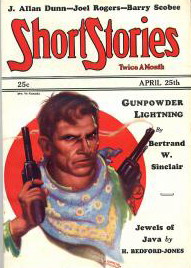
- "The Sea Raider." Short Stories 25 April 1930.
- "The Fly-by-Night." Aces? Date? [referred to in Aces, September 1930].
- "Early Bird." Aces, June (1930 or 1931?) [25 pages].
- "The Spy Squad." Aces, September 1930; II,10:3-54.
They grew flying men on the other side of the lines — proud and fierce men, hawk-quick on the triggers....And Captain the Baron Jongkist was the king-spy and king-hawk of them all, in death, defeat or victory! A Complete War Air Novel.
"At about seven-thirty or eight o'clock of a long, late-glimmering July twilight in 1916 a two-seater German plane, of a very ancient pattern, came buzzing out of a burning gold and scarlet cloud bank two miles above the drome of the 107th Scouts, R. F. C. — near Nouailleaux on the upper Oise, Picardy...." - "The Seventh Man." Aces, March [year?]:52-74.
- Reprinted in Wings, spring 1936.
- Reprinted in Wings, spring 1952; XI,11:74-96.
Six greenhorn Marines turned their motors for first flight over the lines. And doom was due to ride with them — for one of the six was a bloody killer, a double-faced spy.
"Six junior officers in Forest-Green had lined up before Major F. A. Schmolz, commanding officer of the 9th Marine DeHaviland Day Bombing Squadron, operating from Beaux — pronounce it 'Booze' — on the Marne...." - "Sky Guns of Capt. Death." Wings 4 (3), March 1931:3-30.
Here flies the boldest bird of them all — Captain Death, air adventurer! Traitor hands play a hidden ace, and in hours laden with life and death his black wings bear a message of doom. A Complete Air Adventure Novel.
"Swinging his walking stick, with his hat tilted cockily, Captain Death went walking up Connecticut Avenue from Lafayette Park at his quick short brisk military stride, in the cold autumnal night...." - "Ace Traitor." Aces, May 1931 [46 pages].
- "The Crash Club." Wings 4 (5), May 1931:3-28.
A butcher bird skulks in the shadows of the Wing High Country Club. Muder whistles through bright blue sky. Billionaire baby aces cross a sinister slipstream, and Captain Death flies to a rescue. A Complete Air Adventure Novelet.
"Three young men and a girl, all in boots and riding breeches of expensive cut and with goggles looped about their necks, sat idly on a hangar bench in the summer shade beside the flying green of the ultra-fasionable Wing High Country Club. They were smoking cigarets, whispering, giggling, and mildly horseplaying together, while they waited their turns to hop off...." - "Sky-jammers." Aces, June (1931?) [58 pages].
- "The Ace from Missouri." Part one. Wings 4 (8), August 1931:58-82.
–Part two. Wings 4 (9), September 1931:51-76.
–Part three. Wings [4 (10), October 1931].
War — under three flags! Here's a tale echoing out of the mystery mists that the mightiest Allied airmen and spymen strove in vain to pierce. Captain Jannit and his Black Sky Box tearing out of the blood-red west — Tricolor, Starry Banner and Imperial Cross tangling in April air!
"Three miles above Laon Captain Jannit of the Coffin Circus came sweeping from the April sunset cloud in his black, singing Halberstadt. High above the dun-green world. Out of the cumulus vapor which had wrapped him for ten minutes...." - "Lost Aces." Aces 3 (12), November 1931:45-89.
A Complete War Air Novel. Two aces flew to the edge of the world, one toying with treason, one fighting for life in a circle of death. Two aces, two bullets — and only one plane to break a deadlock of doom.
"Two miles above the Ostend Zeppelin sheds the Mary Hen spotted Kenny Blair's little Sopwith darting out of the edges of a drifting cloud mountain — a shimmer of silver wings in the high sunset sky. The Mary Hen pulled off her socks, and she began throwing things...." - "Enter Captain Death." Part one. Short Stories 139 (3), 10 May 1932:8-36
–Part two. Short Stories [139 (4), 24 May 1932?]:100-136
–Part three. Short Stories [140 (1), 6 June 1932?]:100-122.
–Part four. Short Stories [140 (2), 20 June 1932?]:90-122.
Swift-winged, sure, adventure dropped down from the startled clouds in the wake of a gentleman adventurer of the air.
"Booming down the sky lanes towards Washington in his black-winged Lockcairn-Omega, three thousand feet high in the smooth late sunset weather, Captain Death heard his big Hurricane motor begin to cough and miss. He inched his bow down instinctively, and glanced at his instrument panel...." - "The Flying Hearse." Action Novels 4 (4), June 1932:44-82.
On swept the Flying Hearse, full in its mop-up stride through Allied skies. There flew the great Hun Undertaker, leader of the glory flight, chanting a joyful dirge for Paris, the doomed. Nothing awing to stop him — nothing, that is, except, high in the sun, a yellow Sopwith on lone patrol. Its pilot was war-crazed, wooden-legged — its gunner a wild and woolly hombre from the forks of Bitter Creek. Wahoo! Slam open the throttle for the most amazing flight that ever stormed the hot-steel heavens!
"Captain Pussy Kirkhaven — listed in the R.F.C. Operations Office as C.O. of the Quiatsmau Advanced Aerial Gunnery School — strode angrily from his training ship toward the mess hall, bumping his hard crash helmet against his knee as he went. Angel George — better known as Captain Gabriel Raphael St. John George, chief gunnery instructor — had to rattle his wooden leg at a stumping run to keep up with the long-shanked C.O...." - "King of the Camels." Wings 5 (9), September 1932:42-88.
The Iron Man of the German Secret Service hatched a plot to smash England to her knees and blot London from the map....And the first blow was to catch Captain Mulhearn, King of the Camels, and batter him from the sky. A Complete Novel of the Fighting Aces.
"Twelve thousand feet in the air, fifteen miles inside Hunland at broad noon, was no place for a cautious pilot to be riding the clouds alone. That's where Harp Mulhearn was. But then, nobody ever called Mulhearn a cautious pilot...." - "The Gallows Birds." Wings 5 (11), November 1932:30-74.
- Reprinted as "The Sky-Hooting Gyrines." Wings 12 (1), spring 1953:56-95.
The Unholy Three were A. W. O. L. birds in a kiwi outfit and they wanted to hit the air above the battle lines and tangle feathers with the Red Baron....And they fought three armies on the way.
"There were three rather tired and red-eyed gentlemen in Marine Corps forest-green, wearing the gleaming wings of American naval aviators on their unbuttoned tunics, with their split-ess caps shoved wearily on the back of their heads and their shirt collars opened on their sweating necks, who went stumbling and slogging down the deserted side road from Paris toward Compiegne in the dust beneath the hot July afternoon sun...." - "White Thunderbolt." Wings 6 (1), December 1933-January 1934:64-100.
The Allied side of No Man's Land knew Horst von Riegelmann — The Ghost upon the Roof, the Pale Horseman. In his white Albatross he haunted the high ceiling of heaven, ready to start his lunging killer-swoop that crashed unway airmen down to a far Valhalla. Scarred French aces and Belgian veterans, Englishmen and Yanks — they cursed his name, hated him....A War-Air Novel Complete in this Issue.
"High in the twilight sky above the battle lines, twenty-two thousand feet up among the cold thin roof clouds, in his white Albatross III with the red rose of Lorraine which was his battle sign upon it, Captain the Baron Horst von Riegelmann was circling softly, like a white butterfly in the cobwebs of the dusk...." - "Scum Squadron." Wings, July 1934 (50 pages).
- "The Kite Killer." Wings, [1934?].
The only reference I've found to this one is in the letters page of the November 1934 Wings -- which happened to come right before Joel's story "Pay Hop." The letter, from Carleton Burk of Palo Alto, says "...in the past year you have published only two real yarns —'The Devil Flies High' by Martin and 'The Kite Killer' by Rogers. Save your high-powered adjectives for the stories that really deserve them...."
Another letter, from John Bolton of Tacoma, Washington, says "Move those Joel Rogers stories up to the front of the book and feature them every issue. Cut down on Martin and Whitehouse and give us some of the real fact material about war-time pilots...." - "Doves of Doom." Wings 6 (5), September 1934:80-124.
A Complete War-Air Novel. Hun Killers blasting from the sky — and a murdering spy stalking in the fog! Thus did the All-American squadron get its first taste of war — and the worst was yet to come!
. "The yell of the raid siren sounded at five a. m. over the field of Major Texas Scrim's 111th U. S. Pursuit — the Galloping Eleven Squadron — just as Rupe Welsh was settling down to swig a quart of early morning coffee in the mess shack, sleepy and red-eyed, toward the end of his twenty-four-hour tour of duty at O. D. Whee-ya-ha-wow-yow-wow! the siren screamed, and the gray Fokker wings came rushing...." - "Firebirds." Wings, October (1934?) [45 pages].
- "Pay Hop." Wings 6 (7), November 1934,7:78-122.
Take Captain Rene Norck of the famous Vultures and the mighty Max Pavian with his Fokker Killers. Take Private Okie Crow of the Tenth Marines plus the dauntless Major Bean. Mix them together in a hell-bent sky for three solid hours of matchless reading pleasure! A Complete War-Air Novel.
"A mile and a half up in the sun-streaked afternoon sky, just underneath the rolling bunches of cirro-nimbus cloud which were tumbling and traveling eastward like flocks of gray merino sheep, the lone DeHaviland 9 went sweeping around invincibly and fearlessly on battle patrol...."
- "Whirlwind." Wings 6 (8), December 1934:74-120.
In this corner, Barney Jones, the Oklahoma hell-cat--the red headed, double damned crate-crasher — the wildest and wooliest and most hopeless flying cadet who ever broke the heart of a wartime flight instructor....And in this corner — Captain, the Baron, Joahim Karl Von Benz, the Hessian Whirlwind, top-ace and leader of that famous killer crew, the Scarlet Tango....Duel to the death — and no holds barred!
"Out of a cloudy feather-bed three miles above St. Gervaise, with wires whining and motor moaning, with his Spandaus streaking hot, Captain Joahim Karl von Benz, the Hessian Whirlwind, came headlong down to bag his forty-second kill...." - "The Tornado Sweeps." Wings 6 (9), January 1935:64-121.
Kugelmann's gray wave of death is rushing on, and Pavian's Fokkers are sweeping the sky! And only the fledgling Tenth Marines — only a she-spy — to stop them! A Complete War-Air Novel.
"Across the roof of the cloud-smeared sky at the end of that terrible day he came flying, small and high, with red and green zigzag checkeered wings zipping through the cloud and open twilight like a bug through the ravels of a torn cobweb....." - "The Seahorse Marine." Wings 6 (10), Febuary 1935:56-124.
- Reprinted as "Flight into Fury." Wings 11 (8), spring 1950:2-71.
"Down through the dusky twilight sky the green DeHaviland 9 went streaking like a wild lost loon in desperate flight toward the rolling floor of cloud below. Down with howling club and screaming wires...."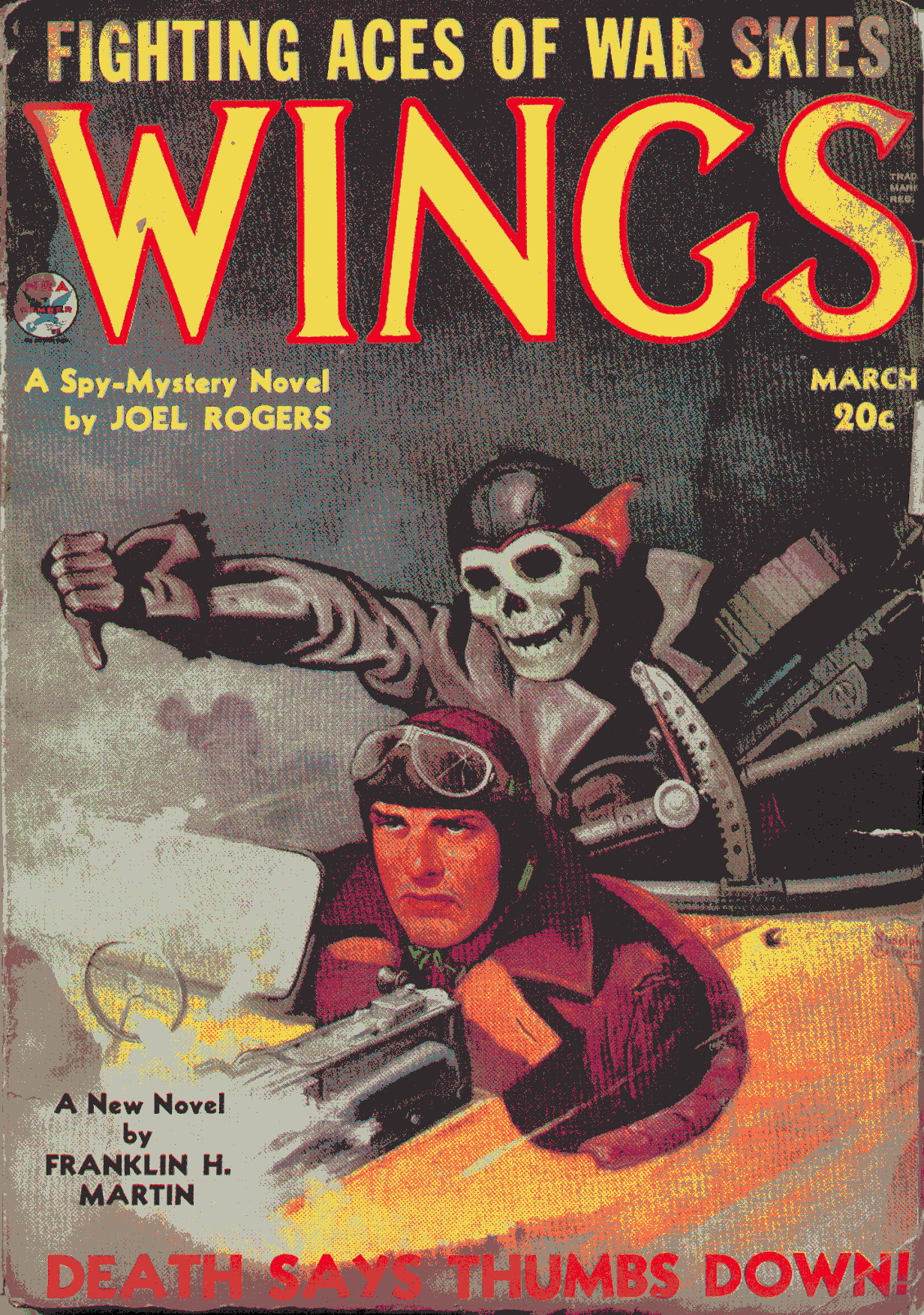
- "The Raid of the Red Dragons." Wings 6 (11), March 1935:74-119.
This is a rewrite — presumably by the magazine's editors — of "The Spy Squad." The british Sub-Lieutenant Stony Broak has been changed to Sub-Lieutenant Stony Rhodes of Savannah, Georgia. The opening sentence has changed from "At about seven-thirty or eight o'clock..." to "At about six-thirty or seven o'clock...."
That ancient Hun crate came swooping down, bearing queer cargo. Defeat for the British, death for the French — and hell-on-wings for the wingless Yankee. - "The Tornado King." Wings, April-May 1935 [58 pp.].
In his 1963 letter to Jack Byrne, Joel said "I have an idea that the last four listed ["Pay Hop," "The Tornado Sweeps," "The Seahorse Marine," and "The Tornado King"] were about those same general characters, Okie Crow the Marine, Max Pavian the German, some French squadron, and some spy named Jacqueline Tonnerre. Characters mentioned by the fan in California [Marvin H. Leaf]."
I haven't read any of those stories myself, but it seems to me Win loved them. I can almost see tears in her eyes as she talked to Joel about those old Okie Crow stories — saying what a shame it was that they should not be republished. - "The Devil Flies Today." Wings, Winter 1936.
- "Locusts from Asia." Part one. Argosy 272 (3), 17 April 1937:32-60.
–Part two. Argosy [272 (4), 24 April 1937?].
A strange and unusual story of the wild days when the Four Horsemen coursed sky and sea and land, when new history was written every hour with the bludgeons of doom, when the insane impossible became the commonplace.
"At twilight, out of the mile-high rolling cloud above Bar-sur-Meuse, above his own squadron hangars, Captain Nick Weaver of the 91st Scouts came dropping suddenly into view, whistling steeply on one wing down towards his tarmac...."
- "The Graveyard Patrol." Wings, Fall 1937 [21 pp.].
- "Pilots Die Young." Wings, Spring 1938.
- "To Hell — and Back." Dare-Devil Aces 30 (3), November 1942:26-53.
"It was in Onomichi or Fukuyama — one of those crowded, roaring paper-and-wood cities along the Honshu shore of the Inland Sea — that Major Kirby Collins of the flying marines saw that damned white man's face a moment, amidst all the swarms of brown-faced, bullet-headed, slant-eyed throngs which pack the narrow streets to scream and jeer at him and young Mallon...."
Joel had been writing mystery stories occasionally at the same time as the flying stories — some, evidently, like "The Fool Killer" and "Dead Red Ants," among his earliest work:
- "The Fool Killer." Adventure, 20 June 1923 [64pp.].
In a letter (not dated, but evidently written in June 1936) to a Miss Virginia Venable at a New York company called Stanley Hergerman, Inc., Joel mentioned "The Fool Killer" — apparently in response to Miss Venable's query about stories Joel might consider suitable for movie production. - "Dead Red Ants." Adventure, 10 September 1924.
Edmund Vosik gave me the bibliographic information for this story and said "It would fit in the Mystery section but there is aviation in it too." He also wrote: "I don't remember where I got that copy of Adventure. It must have been a lucky accident since I never saw that story in any index. It's too bad the original manuscript isn't around since Adventure dashed out the damn's and God's and a couple of toher words that I couldn't figure out. I could never understand why EQ only reprinted 'The Murderer' of all the many dazzling JTR stories. . . . It's too bad EQ doesn't do much reprinting any more and AH only prints 1 "Mystery Classic story per issue — usually a story easily obtainable elsewhere. I would love to see a volume of JTR's shorter stories published (although reading more than a couple at one time would leave any reader groggy and disoriented)." - "The Mail from Dead Man." Action Novels 2 (4), June 1930:3-54.
Durkin blood was spilled again in Kaintuck's backwoods — when flaming ganster gats swooped down from the skies. Little Joe, the cripple who shivered in the dark, was left....And the feud challenge was his to answer. Complete Action Adventure Novel.
"Four desperate men were in the cabin of the black-and-silver Bellman-Hurricane ship flying south over the Blue Ridge. She was up twelve thousand feet, above a rolling cloud ceiling, and it was a moonless October night...."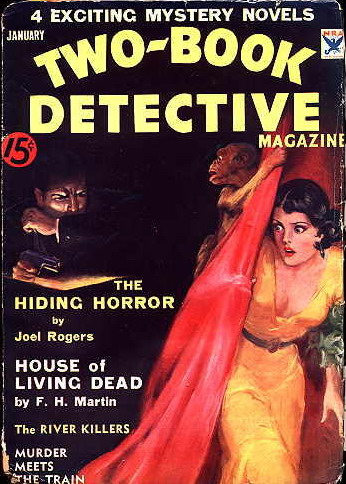
- "Blood on My Doorstep." (Magazine and date unknown.)
- "Die a Little Longer." (Magazine and date unknown.)
- "Too Game to Die." War Novels 2 (33), September 1930:44-81.
- "The Fighting Breed." War Stories 30 (87), November 1930:8-48.
- "Vengeance Is Mine." Pictorial Review, March 1933.
- "Murder of the Dead Man." Detective Fiction Weekly , 28 July 1934].
- Reprinted in Killing Time and Other Stories (Shreveport: Ramble House, 2007).
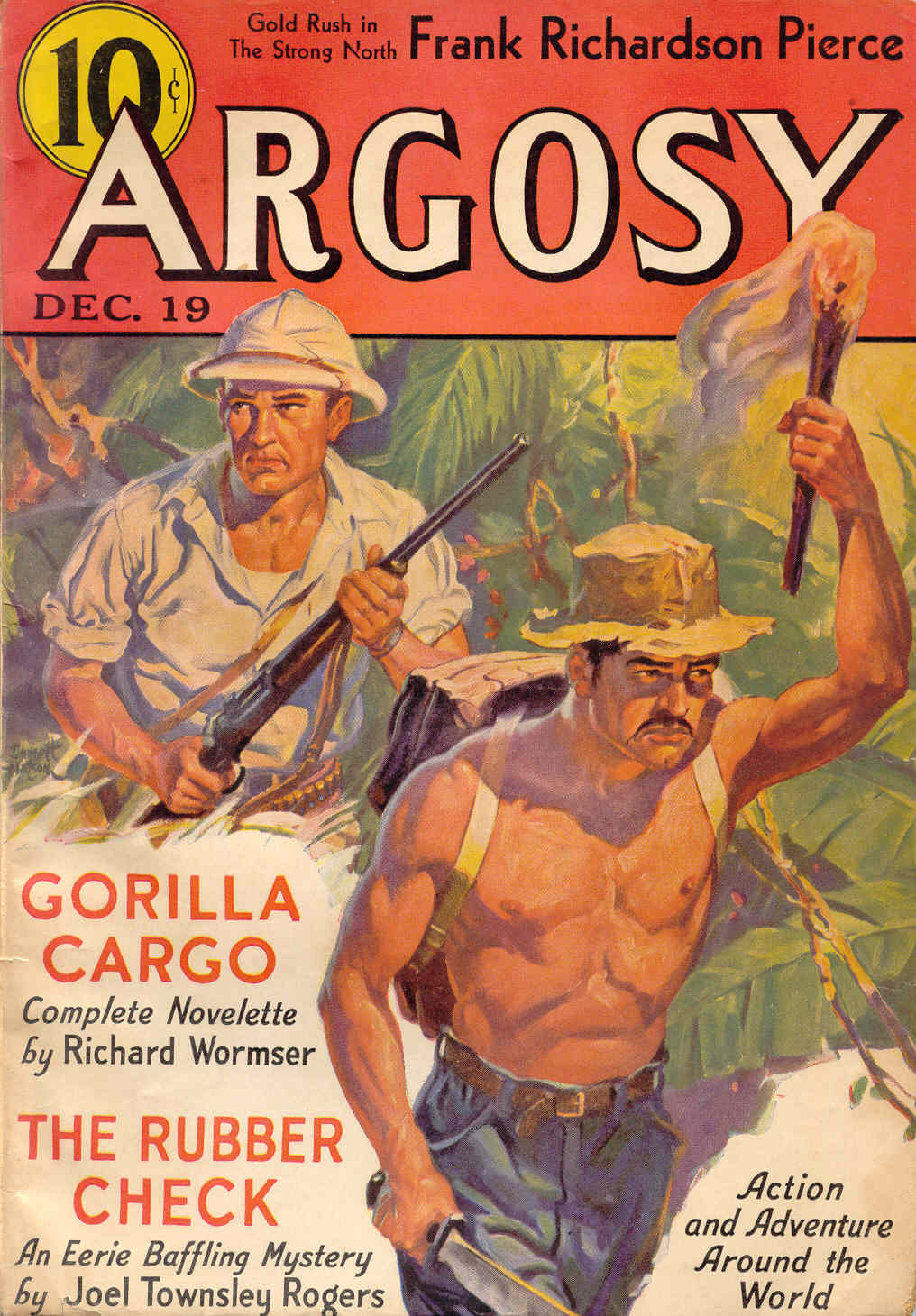
- "The Hiding Horror." Two-Books Detective Magazine, January 1935. ("Joel Rogers")
- Reprinted in Killing Time and Other Stories (Shreveport: Ramble House, 2007).
- "The Eel Walks." Detective Fiction Weekly, August 3-10, 1935.
- " Body of the Missing." Part 1. Detective Fiction Weekly, 14 December 1935.
–Part 2. Detective Fiction Weekly, 21 December 1935.
–Part 3. Detective Fiction Weekly, 28 December 1935. - "The Rubber Check." Argosy Magazine, 19 December 1936.
- "Blind Is the Night." Argosy Magazine?, date unknown. (Mentioned in Argosy, 2 August 1941, along with "The Rubber Check.")
- "Plot for Murder." Detective Fiction Weekly, 14 August 1937.
- "Hark, Africa!" Adventure. Date unknown. It's featured on the cover of a 15-cent Adventure magazine that also lists MacKinlay Kantor and Maurice Walsh.
- "Killigee Swamp." Popular Detective, September 1937.
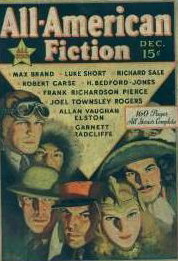
- "Lonesome Road." All-American Fiction, December 1937:6-25,129-154.
I found this one mentioned on an internet site that sells old pulp mags, and Nikki Fletcher of www.prevuemag.com sent me its title and opening lines. I'm assuming it's a mystery tale, but don't know for sure:
"Barefooted, clad in ragged overalls with one strap missing and a torn faded shirt, Richard Wiltshire sat on the sagging front porch of his clap-boarded mountain shack...." - "The Crimson Vampire." Detective Book Magazine, Spring 1938. ("Joel Rogers")
- Reprinted in Killing Time and Other Stories.
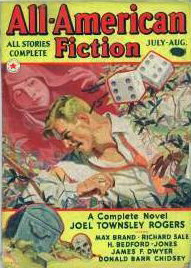
- "A Date with Lachesis." [Argosy, (month?) 1938.] All-American Fiction, July-August 1938.
I had this down as Argosy, but now I find a cover of All-American Fiction for July-August 1938, with a cover illustration corresponding to the story's plot. Joel later turned this into the book-length Lady with the Dice. - "Drum Patrols." Adventure?, (month?) 1940.
- Reprinted in Adventure, February 1955:31,40-46.
- "Mass Murderer." Detective Fiction Weekly, 5 July 1941.
- Reprinted in New Detective Magazine, February 1951, as "The Last Mrs. Hankler."
The reprint was poorly edited. In the original story there was a family name Boogie. I guess the new editor didn't like that name so it was changed to Campbell. Only it was missed in several places. I wonder what readers thought when members of the Campbell family were being called Boogie.
- "Pink Diamonds." Argosy, 2 August 1941.
Philip J. K. Rogers got this information from a book shop that came across this issue of Argosy (the issue, they said, marking a change in Argosy's format "to a typical magazine size"): "This one is featured on the cover — quite nicely! . . . The cover illustration is for this story, and the sub-text reads, 'He Dies, Who Steals the Devil's Jewels!'"- Reprinted in Night of Horror and Other Stories.
- "Murderer's Last Smoke." Detective Fiction Weekly, 2 August 1941. ("Joel Rownsley Rogers")
- Reprinted as "The Lights of Sing Sing." Detective Fiction, February 1951.
- "Ten Thousand Witnesses." Detective Tales April 1942.
- "Commandos Fight Alone!" Dare-Devil Aces September 1942.
- "Five Dumb Men and the Highfish." Big-Book Detective Magazine 2 (2), October 1942.
A german U-boat crew landing in New Jersey. - "Death Is My Domain." Action Stories, winter 1943: 38-53.
- "The Dead Can't Die." Detective Tales, January 1943.
- "The Mercy of Hadj Aleman." Action Stories, summer 1943:102-127.
Details again courtesy of Nikki Fletcher:
"A complete novel of Spain. The Moorish Legion watched the border, and what could escape hungry Riff swords? And yet—could they take the blood of the red-haired American and the little man whom the Gestapo sought with insane desire? An Unforgettable Novel of the Swastika in Spain." - "The Return of the Murderer." Part 1. Flynn's Detective Fiction, May 1944.
–Part 2. Flynn's Detective Fiction, June 1944.- Reprinted in New Detective Magazine, June 1951.
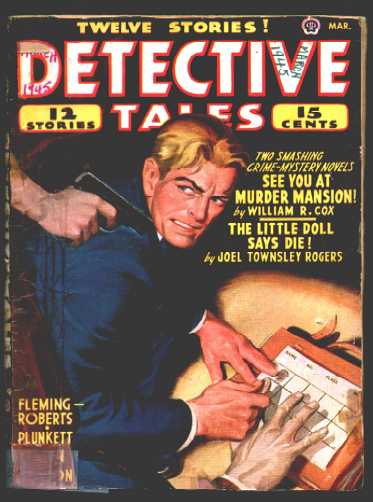
- "The Little Doll Says Die." Detective Tales, March 1945.
- Reprinted in Night of Horror and Other Stories.
- "The Red Right Hand." New Detective Magazine, March 1945.
The short story that Joel later turned into what would be a classic mystery novel.- Reprinted in Killing Time and Other Stories.
- "The Hanging Rope." New Detective Magazine, September 1946.
- Reprinted in Night of Horror and Other Stories.
- "Mayhem-Cum Laude." New Detective Magazine, November 1946.
- "The Murderer." The Saturday Evening Post, 23 November 1946.
- Reprinted in The Saturday Evening Post Stories 1946. New York, New York: Random House, 1946.
- Reprinted in The Saturday Evening Post Treasury in 1954..
- Reprinted in Ellery Queen's Anthology, 1960 (issue?).
- Reprinted in Ellery Queen's Anthology, spring-summer 1977, pages 242-258.
- Reprinted in Alfred Hitchcock's Mystery Magazine, July 1995.
- Reprinted in Night of Horror and Other Stories (Shreveport: Ramble House, 2006).
- "My Friend Death." New Detective Magazine, May 1947.
- Reprinted in Killing Time and Other Stories (Shreveport: Ramble House, 2007).
- "Killing Time." New Detective Magazine, July 1947.
- Reprinted in Killing Time and Other Stories (Shreveport: Ramble House, 2007).
- "Red Runs the Tide." New Detective Magazine, May 1948.
- "The Murder Plot." Mystery Book Magazine 8 (2), Spring 1949.
- Reprinted in Night of Horror and Other Stories (Shreveport: Ramble House, 2006).
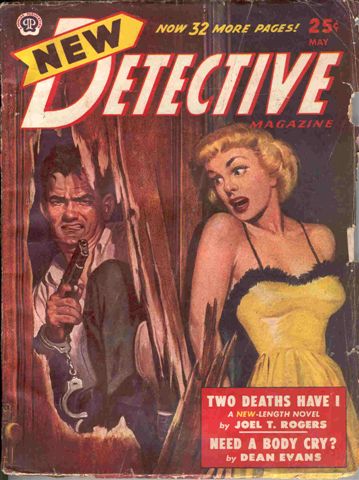
- "Two Deaths Have I." New Detective Magazine, May 1949.
- Reprinted in Night of Horror and Other Stories (Shreveport: Ramble House, 2006).
- "Blood on My Doorstep ." New Detective Magazine, July 1949.
- "Die a Little Longer." New Detective Magazine, July 1950.
- "Night Before Murder." New Detective Magazine, September 1950.
- "The Belated Corpse." Detective Fiction, May 1951.
- "When the Devil God Smiled." Dime Detective Magazine, June 1952.
I've spoken above of the publication of Joel's first book, Once in a Red Moon, which came out in 1923.
Lee Wright, a Simon and Schuster editor, seems to have been instrumental in getting The Red Right Hand published. She had seen it as a short story (evidently still in manuscript form, since — according to Edward D. Hoch's foreword to the latest Carroll & Graf paperback reprint — the story was not published in New Detective Magazine till March 1945, just a couple of months before the book came out) and on 7 July 1944 wrote Joel "I have fallen very much in love with THE RED RIGHT HAND, and would love to discuss with you the possibilities of lengthening it to fit book publication." It was apparently the best-selling title in S&S's Inner Sanctum mystery series.
CLEMENTINE Shit. Shit. I know it's here. Hold on. She dumps the contents of the bag onto the seat and sifts frantically through. Joel sees the book she was reading in the diner. It's The Red Right Hand by Joel Townsley Rogers. Joel eyes the book. CLEMENTINE (CONT'D) Damn it. DAMN IT! (there it is) Oh. Here. ........................................................... CLEMENTINE I don't believe in that soulmate crap anymore, but... Patrick says so many great things. We like the same writers. This writer Joel Townsley Rogers he turned me on to. JOEL Yeah, he's one of my favorites. I saw you had his book in your purse. ........................................................... 86 INT. JOEL'S APARTMENT - DAY 86 It's raining out. Joel and Clementine are lying huddled on the couch. They are reading a book together. It's The Red Right Hand by Joel Townsley Rogers. Joel finishes the page first. Clementine, in panties and bra, reads slowly, uses her finger. JOEL Done? [...] Clementine looks over at him, smiles. CLEMENTINE Done. This book is weird. But cool.Excerpts of three scenes from the weird, cool, and brilliant shooting script for Eternal Sunshine of the Spotless Mind by Charlie Kaufman -- not included in the actual movie |
The first paperback reprint, a Pocket Book edition, came out in October 1946. (Winibee still remembers accompanying Joel to the publication party in the Rockefeller Center's Rainbow Room and Joel getting crocked. She walked him back to his hotel room and made a cup of instant coffee with hot tap water.) Dell did another paperback reprint in 1957 for its Great Mystery Series, Pyramid did one, perhaps in the 1970s, and Carroll & Graf did reprints in 1983 and again in 1997.
It also came out in a handsome new hardcover edition in The Mystery Library published by the University of California at San Diego in 1978. Along with the novel, this edition contained a couple of critical essays about The Red Right Hand — plus a 1922 poem of Joel's called "The Marauders."
The Red Right Hand was translated into several other languages. French (two translations). Spanish (El mano derecho, I believe). Portuguese. Icelandic. And possibly german, though I'm not sure about that. The first french translation, Jeu de massacre, won the Grand Prix de Litterature Policiere when it came out in 1950, and I remember that the back cover had a blurb saying something to the effect that "J. T. Rogers est la pseudonym d'un haut fonctionairre de le Departement d'État en Washington, D.C." (This was when Joel was making ends meet as a guard at the Army Map Service.)
With regard to the spanish translation, Joel wrote in 1954, "I have no Spanish, nor a copy of the book, one of the two copies I had having been sent to Mrs. Truman, who was then studying Spanish, and the other lent to Lt.-gen. Ruiz, former Mexican military attache to the U. S., who had no English, and who thought it was a gift."
Mrs Truman got a copy because Joel's mother, a fellow missourian, thought she should have it. As for General Ruiz, he was one of Grams's neighbors, living on the opposite side of Thirtyfirst street.
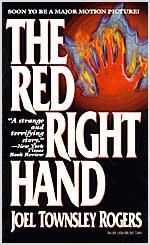 .
.
In 1946 Joel had another book ready for publication, a slender paperback mystery called Lady with the Dice, which was expanded from a 1938 Argosy story called "A Date with Lachesis." Lee Wright didn't find it suitable for Simon and Schuster, so it was published in paperback as a Handi-Book Mystery instead.
In 1958 Simon and Schuster finally published another of Joel's books in its Inner Sanctum series — The Stopped Clock. Like The Red Right Hand, Joel had expanded it, at the request of an editor, from a magazine story — this one called "The Return of the Murderer." It was a slow-moving story that did not sell well. Joel's friend Jake Jakobsson did a cheap paperback reprint a year or two later, with a half-naked woman on the cover and the title changed to Never Leave My Bed.
Some reviews from the 1958 Book Review Digest:
"Lushly overwritten and not too easy to like."—Kirkus 1 Feb 1958. "Complex account of the murder of a still remembered if long retired film star is slow, laborious, heavy, an attempt to sustain rapture at enormous length. This is a condition not natural to rapture."—James Sandoe, New York Herald Tribune Book Review, 18 May 1958. "A Rogers story in synopsis might seem unlikely or even absurd. In the reading it's a vortex of emotional compulsion, which may not be art but is certainly an experience. . . . It's all about twice as long as the average suspense novel, five times as intricate and ten times as exciting."—Anthony Boucher, New York Times, 27 April 1958. "The coincidences are so many that your belief may be strained." L. G. Offord, San Francisco Chronicle, 1 June 1958. "Over-adjectived and superdetailed, also repetititive. Spotty."—Saturday Review, 11 Oct 1958.
At the risk of sounding like the viperous ingrate that I am, I have to say — without going back to reread the book — that I agree with all of those reviews except Boucher's. I have to wonder what book he thought he was reading. But of course I am grateful to him, nonetheless, for having given Joel that one good review.
After Joel's death one more book came out, in 1985: a french edition called Cauchemar d'une nuit d'eté — "Nightmare of a Summer Night" — which was a translation by Stephane Bourgoin of a couple of Joel's old mystery stories. Bourgoin was thinking of collecting and translating more of the old stories, and I sent him five or six I had copies of, but evidently he gave up the idea.
Let me note here that Fender Tucker has generously brought back into print, in his on-demand publishing enterprise, all of Joel's novels other than The Red Right Hand (which I think is still available from Carroll and Graf) — that is, Once in a Red Moon, Lady with the Dice, and The Stopped Clock. And now he has also brought out a couple of collections of Joel's short stories.
The first, Night of Horror and Other Stories (Shreveport: Ramble House, 2006), includes seven stories: "Pink Diamonds," "The Little Doll Says Die!," "The Hanging Rope," "The Murderer," "The Murder Plot," "Two Deaths Have I," and "Night of Horror."
The second, Killing Time and Other Stories (Shreveport: Ramble House, 2007), has half a dozen: "Murder of the Dead Man," "The Hiding Horror," "The Crimson Vampire," "The Red Right Hand" (the original magazine story), "My Friend Death," and "Killing Time." You can order any of these editions through Fender's website www.ramblehouse.com, where he has his own Joel Townsley Rogers page. Alternatively, you can order them directly through Lulu.com.
Joel also wrote a few science-fiction stories, from the late 1930s into the 1950s — some of them quite wonderful and one, at least, earning a permanent place in Anthony Boucher's handsome two-volume science-fiction treasury. (Boucher was always a partisan of Joel's. He was the editor of Dell's Great Mystery Library, which brought out a paperback edition of The Red Right Hand in 1957, and, as you can see from the review quoted above, he even liked The Stopped Clock. Bless him.)
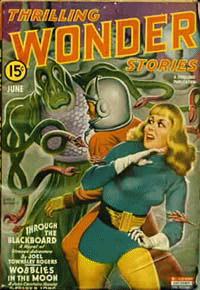
Thrilling Wonder Stories, June 1943. Joel's story "Through the Blackboard" is described on the cover as "a Novel of Strange Adventure." |
One of them, "Moment without Time," which appeared in 1952, became dated when Stalin died. But it still made me cry when I read it. (According to an internet source, the first publication was in Thrilling Wonder Stories in April 1952; but the story was later reprinted in Best from Startling Stories. I assume the two magazines were sister publications.)
There was a romantic one called "No Matter Where You Go," which brought readers to an Earth where people grew younger instead of older.
And one that The Saturday Evening Post paid $1250 for in 1958 called "Night of Horror." (Joel's name for it was "Takes Hold with Her Hands," a biblical quotation: The spider takes hold with her hands, and is in kings' palaces. The story dealt with a huge mutant spider, and the folks across the street from the protagonist were named the Kings.)
I thought I had at least a complete listing of the titles, if not the dates, of Joel Townsley Rogers's fantasy and science-fiction stories, but the day after I put this page onto the internet I found another of his stories listed on the internet — "Through the Blackboard," which evidently appeared in June 1943 in Thrilling Wonder Stories. The story is described on the cover as "a Novel of Strange Adventure."
And a few months later I found I found mention on the internet of still another, "Death Is My Domain," published in 1943. And
Here, anyway, is an attempt at a list:
- "Hark! The Rattle." Weird Tales, March 1923.
Haven't seen this. I assume it's fantasy since it appeared in Weird Tales.
- "Beyond Space and Time." All-American Fiction, February 1938.
- Reprinted in Super Science Stories 7 (2), September 1950.
- Reprinted in A Treasury of Great Science Fiction. Ed. Anthony Boucher. Garden City, NY: Doubleday and Company, 1959; 380-399.
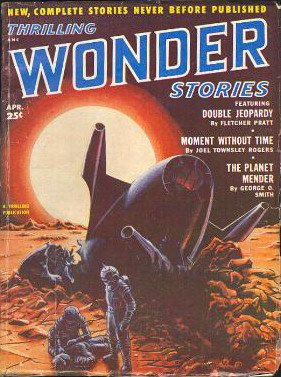
- "Through the Blackboard." Thrilling Wonder Stories, June 1943.
- "Death Is My Domain." Action Stories, winter 1943; 38-53.
Description from Nikki Fletcher: "A Novelet of Tomorrow's Skyways. The conquering hosts had marched up and down the world, and now the Emperor was flying in the sky dreadnaught to take possession of his last dominion. Two miles above the green and purple sea...." - "Moment without Time." Thrilling Wonder Stories, April 1952.
- Reprinted in Best from Startling Stories. New York: Henry Holt, Inc.; 1953.
- "The Night the World Turned Over." Startling Stories, November 1952.
- "Night of Horror." The Saturday Evening Post, 7 June 1958.
- Reprinted in The Saturday Evening Post Stories 1958. Garden City, NY: Doubleday and Company, 1958.
- Reprinted in Night of Horror and Other Stories (Shreveport: Ramble House, 2006).
- "No Matter Where You Go." The Magazine of Fantasy and Science Fiction, February 1959.
- Reprinted in The Best from Fantasy and Science Fiction, Ninth Series. Ed. Robert P. Mills. Garden City, NY: Doubleday and Co., 1960; pages 201-222. (This anthology came out also as an Ace paperback, according to information gleaned from the internet, in 1964.)
- Translated as "Reflet dans un miroir." Fiction, November 1970, Number 203; 129-148.
There were also a few less easily classifiable stories. One called "His Name Was Not Forgotten" — about an Indian attack on one of Abraham Lincoln's ancestors, I believe — appeared in The Saturday Evening Post of 28 August 1943 and was reprinted in Great Westerns from the Saturday Evening Post, edited by Julie Nixon Eisenhower and published sometime in the 1970s. (According to an internet source, it was also reprinted in 1985 in — strangely enough — A Treasury of American Horror Stories, an "instant remainder" book put out by Crown Books.)
One of my personal favorites is a story called "I'll See You Tomorrow." It too — like "Moment without Time" — makes me cry, and it too is outdated, a "what if?" story leading towards Hitler's assassination as "Moment without Time" leads towards Stalin's. But both stories are gripping and deeply emotional. Joel had sent this fine story to Argosy but then had second thoughts and sent a copy to his old friend Stuart Rose at the Post, telling him the Post could have it if Argosy decided against it. Stuart Rose did want it and wrote back to Joel, "Argosy would be crazy not to take it." And in fact they did take it, and changed its name from the lovely, meaningful one my father had given it to "Tomorrow the Deluge" and published it (with a photo of little Joey and little me included in the magazine's front matter) probably in 1944. The Post would have paid several times as much as Argosy and would have had a wide audience and doubtless would have been reprinted and anthologized. But Joel felt that he'd given his word to the folks at Argosy and could not take the story back to give to the Post. I think he regretted it the rest of his life.
As for nonfiction, there was very little of it. There was one poem, "Shadows of the Silver Screen," that was published in 1921. A bit about his early flying days — actually a letter he'd written to his parents in February 1918 — appeared in the 1950s or 1960s in some little aviation magazine. And in July or August 1944, judging from a couple of fan letters, an article called "Singing in the Wilderness" in Writer's Digest. Here's the start of a fivepage letter from an Independence, Missouri, freelancer named Verne F. Ryland:
Dear Mr. Rogers:Broke? Yes, Mr Ryland, it was true. That much I can vouch for. It was true.
I just finished reading your fine article-letter in the W/D which I received today. Are you kidding? I mean about being broke for all practical purposes? I have read some of your stuff in the past, and I can't see how in the world a man as capable as you are should say that.

Many thanks to everybody who has sent comments and additional bibliographic information — especially my nephew, Philip J. K. Rogers. I welcome all corrections, additions, and suggestions. Send email to: TNRRogers AT gmail DOT com. (But put that address into standard email format, using @ instead of AT and . instead of DOT.)

Home page
Parents
Joel Townsley Rogers — an unannotated bibliography
Siblings
Winibee
Jackie
Julie
Joey
Maureen
Joel
Friends
Places
Publications
Copyright (c) 1999–2008 T. N. R. Rogers. All rights reserved. Last revised 22 jan 2008.
